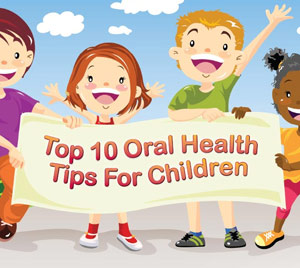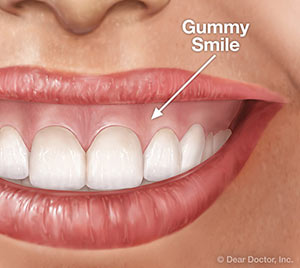Search Results
161 content pages
All About Toothpaste
Toothpaste: It's something most people use every day, but rarely give much thought to — except, perhaps, when choosing from among the dozens of brands that line the drugstore shelf. Is there any difference between them? What's toothpaste made of… and does it really do what it promises on the box? To answer those questions, let's take a closer look inside the tube.
The soft, slightly grainy paste that you squeeze on your brush is the latest in a long line of tooth-cleaning substances whose first recorded use was around the time of the ancient Egyptians. Those early mixtures had...

Top 10 Oral Health Tips For Children
There's no need to wait until your baby actually has teeth to lay the foundations for good oral or general health. In fact, good nutrition and oral hygiene can start right away. It is up to you to develop the routines that will help protect your child from tooth decay and other oral health problems. So let's get started!
1) Start Proper Oral Hygiene Habits ASAP
Gently clean your infant's gums and newly erupting first teeth after each feeding with a water-soaked gauze pad or damp wash cloth.
2) Brush With Care
When your baby's teeth come in, brush them...

Laser Decay Diagnosis
Laser technology is becoming quite commonplace in a wide variety of areas throughout the healthcare industry; but did you know that it can now be used to detect tooth decay? Today, using a small, handheld device, it is possible to detect tooth decay that is not yet visible and would otherwise be undiagnosed by conventional methods alone.
Plus, traditional methods of detecting tooth decay are much more accurate and efficient when used in conjuction with laser technology. You can expect:
dramatically improved early cavity detection
reduced size and possibly number of fillings that might be needed, thus possibly lowering the...

Periodontal Laser Treatment
Since their invention in the early 1960s, lasers have found ever-increasing applications in medicine and dentistry. The latest generation of lasers is now being used in various dental procedures, ranging from disease detection to soft-tissue treatments, and even some hard-tissue procedures like the preparation of small cavities for fillings. One promising area where this technology is having an impact is the field of periodontal (gum) therapy.
Why are more periodontists using lasers? In general, these high-tech tools seem to offer several advantages over conventional treatments for soft-tissue procedures. They are considered minimally invasive treatment methods, meaning that it's possible to...

Endodontics
Endodontics is the dental specialty that deals with tissues and structures located inside the tooth. One of the most common endodontic treatments is root canal therapy, a procedure which effectively eases the pain associated with a bacterial infection deep within the pulp of the tooth. Of course, root canal treatment doesn't just relieve pain — it also stops the infection by removing dead and dying tissue from the tooth's pulp. Plus, it helps to save the tooth, which is in danger of being lost if left untreated.
Yet root canal therapy isn't the only treatment endodontics offers. This field also...

Invisalign Clear Aligners
When you hear the word “orthodontics,” what comes to mind? Probably a young teenager whose teeth are covered by a latticework of metal. There are indeed many orthodontic patients who fit that description. However, there now exists an increasingly popular alternative to traditional metal braces: Invisalign® clear aligners.
As the name implies, Invisalign clear aligners are made of almost invisible polyurethane plastic. Rather than being cemented or bonded to the teeth as metal or clear braces are, clear aligners are completely removable — for important social occasions, for eating, and, most importantly, for tooth-brushing and flossing. This advantage can also...

Adult Orthodontic Treatment
There are more and more adult orthodontic patients these days, and it's not hard to figure out why. Appliances that are barely noticeable have been developed to give adults more discreet choices when it comes to orthodontic treatment. And many adults realize that investing in a smile makeover can have significant benefits, socially and professionally. Straightening teeth can be an important part of that confidence-boosting makeover process.
Healthy teeth can be moved at any age, so there's no such thing as being too old for braces. However, orthodontic treatment for adults is different in two important respects: For one thing,...

Fixed Dentures
If you have lost an entire arch of teeth (top and/or bottom), or are soon to have your remaining teeth removed because they are too unhealthy to save, you may be able to replace them with fixed dentures supported by dental implants. Doctors and patients alike prefer fixed over removable dentures because they:
Look, feel and function just like natural teeth
Don't slip when you eat or talk
Help prevent bone loss in the jaw
Can last a lifetime
How It Works
Dental implants serve the same purpose as the roots of natural teeth: anchoring the replacement teeth to your...

Frequently Asked Questions About Dental Implants
What are dental implants?
Dental implants are small titanium posts that replace the roots of missing teeth (View Example). They are inserted into your jawbone during a minor surgical procedure that takes place in the dental office. After the implant has been placed in your jawbone, a completely lifelike porcelain tooth crown is attached. In some cases, the implant needs to fuse with the bone for several months before it is permanently crowned; in other cases, you can have new (but temporary) teeth the same day your implants are placed.
How many teeth can be replaced with dental implants?
You...

Invisalign Treatment for Teens
There's a technology that's (literally) putting a smile on plenty of young faces: the Invisalign® system of clear, removable aligners made especially for teens! If you (or a teenager you know) are a candidate for this treatment, you might find it's the best fit for your lifestyle: It lets you eat what you want, makes it easier to clean your teeth — and best of all, it's virtually invisible.
Are clear aligners right for you? It all depends on what kind of orthodontic treatment you need. Traditional metal braces still work best in some situations — and you might be...

Anesthesia Wand
If you've ever had needle phobia, you might like to learn about a new technology referred to as an “anesthesia wand,” which is a computer-controlled dental-injection tool. In fact, some people feel it is more of a “magic” wand because it doesn't look like a typical injection and it works even better by making the entire process virtually painless.
Here's how it works
Your anesthesia will be delivered through a syringe-free wand or pen-like device that is connected to a computer. Before the tiny needle attached to the wand is inserted, the computer delivers a small amount of anesthetic so...

Oral Diagnosis and Biopsies
When you come into the dental office for an examination, you might assume that the focus is on your teeth. That's often correct — but don't forget that there are a number of other parts of the oral and facial anatomy that are examined as well. These include areas around and inside the mouth (such as the lips, gums, hard and soft palate, and the tongue) as well as outside the mouth (the skin, muscles and glands in the neck, and the temporomandibular joint). In fact, when it comes to detecting certain oral or systemic (whole-body) diseases, a thorough dental...

Gum Injuries
When dental emergencies and pain occur, our attention is often focused on diseases and injuries related to the teeth. However, it's important to remember that the soft tissues of the mouth — the gums, tongue, lips and cheek lining — may also be affected. While they are tough enough to stand up to the oral environment, these tissues can be damaged by accidental bites, falls, sports injuries, and scalding liquids. They may also suffer injury from foreign bodies that become lodged below the gum line, and they can develop painful and potentially serious abscesses.
First Aid for Soft Tissues
Soft...

Gummy Smiles
Some people feel self-conscious about smiling because they believe their gums are too prominent. Though we each have our own definition of what makes a smile beautiful — including how much gum is too much — a smile will usually be perceived as “gummy” when 4 millimeters (just over an eighth of an inch) of gum tissue shows. If your smile looks gummy to you, it's important to figure out exactly what's causing this. Only then can the appropriate cosmetic dental or periodontal (gum) procedures be recommended to give you a more pleasing appearance of the gums and teeth.
Causes...

Smile Makeover
Smiling with confidence makes you feel great. A beautiful smile is also an important social and professional asset. Yet there are many people who avoid showing their teeth in public or in photographs because they don't like what they see. If that describes you, then why not start the process of getting the smile you've always wanted with a smile makeover?
A smile makeover goes beyond simply responding to dental problems as they arise. It's a comprehensive smile-rejuvenation plan that's uniquely suited to your own facial features and aesthetic preferences. The results can be quite dramatic — both in terms...